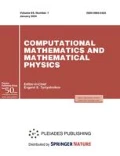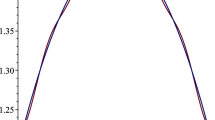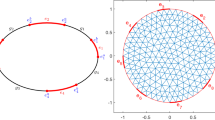Abstract
A generalized inverse problem for the identification of the absorption coefficient for a hyperbolic system is considered. The well-posedness of the problem is examined. It is proved that the regular part of the solution is an L 2 function, which reduces the inverse problem to minimizing the error functional. The gradient of the functional is determined in explicit form from the adjoint problem, and approximate formulas for its calculation are derived. A regularization algorithm for the solution of the inverse problem is considered. Numerical results obtained for various excitation sources are displayed.
Similar content being viewed by others
References
A. S. Blagoveshchenskii, “An Inverse Problem in Seismic Wave Propagation Theory,” in Problems in Mathematical Physics (Leningr. Gos. Univ., Leningrad, 1966), pp. 68–81.
K. T. Iskakov and S. I. Kabanikhin, “The Solution of One-Dimensional Inverse Problem of Geoelectrics by the Method of Conjugate Gradients,” Russ. J. Theor. Appl. Mech. No. 3, 78–88 (1991).
O. A. Ladyzhenskaya, Mixed Problem for a Hyperbolic Equation (Gostekhteorizdat, Moscow, 1953) [in Russian].
O. A. Ladyzhenskaya, The Boundary Value Problems of Mathematical Physics (Nauka, Moscow, 1973; Springer-Verlag, New York, 1985).
L. Garding, Cauchy’s Problem for Hyperbolic Equations (Univ. of Chicago, Chicago, 1958; Inostrannaya Literatura, Moscow, 1961).
A. V. Baev, “On Local Solvability of Inverse Dissipative Scattering Problems,” J. Inverse Ill-Posed Probl. 7(3), 201–220 (1999).
H. Gajewski, K. Gröger, and K. Zacharias, Nichtlineare Operatorgleichungen und Operatordifferentialgleichungen (Akademie, Berlin, 1974; Mir, Moscow, 1978).
A. N. Tikhonov, “On the Solution of Nonlinear Integral Equations of the First Kind,” Dokl. Akad. Nauk SSSR 156, 1296–1299 (1964).
A. M. Denisov, Introduction to the Theory of Inverse Problems (Mosk. Gos. Univ., Moscow, 1994) [in Russian].
F. P. Vasil’ev, Solution Methods for Extremal Problems (Nauka, Moscow, 1981) [in Russian].
Author information
Authors and Affiliations
Additional information
Original Russian Text © A.V. Baev, N.V. Kutsenko, 2006, published in Zhurnal Vychislitel’noi Matematiki i Matematicheskoi Fiziki, 2006, Vol. 46, No. 10, pp. 1882–1893.
Rights and permissions
About this article
Cite this article
Baev, A.V., Kutsenko, N.V. Identification of a dissipation coefficient by a variational method. Comput. Math. and Math. Phys. 46, 1796–1807 (2006). https://doi.org/10.1134/S0965542506100150
Received:
Accepted:
Issue Date:
DOI: https://doi.org/10.1134/S0965542506100150




